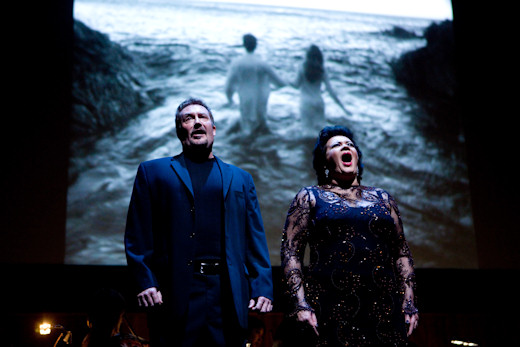Other Links
Editorial Board
- UK
Editors
- John Quinn and Roger Jones
Editors for The Americas - Bruce Hodges and Jonathan Spencer Jones
European Editors - Bettina Mara and Jens F Laurson
Consulting Editor - Bill Kenny
Assistant Webmaster -Stan Metzger
Founder - Len Mullenger
Google Site Search
SEEN AND HEARD UK OPERA REVIEW
Wagner, Tristan und Isolde - Birmingham Performance:
(Semi-staged with video projections) Soloists, Philharmonia Voices, The
Philharmonia Orchestra, conductor Esa-Pekka Salonen, Symphony Hall, Birmingham, 23.9.2010 (BK)
Tristan – Gary Lehmann
Isolde – Violeta Urmana
Brangäne – Anne Sofie von Otter
King Marke – Matthew Best
Kurwenal – Jukka Rasilainen
Melot – Stephen Gadd
Shepherd/Sailor – Joshua Ellicott
Helmsman – Darren Jeffery
Philharmonia Voices
Production
Video Art – The Bill Viola Studio in association with the National Opera, Paris; the Los Angeles Philharmonic Association, the Lincoln Center for Performing Arts and the James Cohan Gallery, New York; Haunch of Venison, London
Direction / Artistic Collaboration - Peter Sellars

Tristan (Gary Lehmann) and Isolde (Violeta
Urmana)
Photo © Ben Ealovega - Video Projection © The Bill Viola Studio
Nominally semi-staged - though in fact the only 'prop' to be seen was a small
black box for the principals to sit on from time to time, or for Tristan to
lie on in Act III - the production had two very interesting elements.
Director Peter Sellars had the idea of using the whole of Symphony Hall as a
performance space, with the excellent Philharmonia Voices perched in the upper
balcony above and behind most of the audience and with some soloists singing
from the hall's circle tier. The resulting surround sound was simply stunning.
Bill Viola's video projections were the other innovation. A large screen
hanging behind the orchestra showed a silent commentary on the characters'
inner emotions as a complement to their behaviour 'on stage'.
While many of the images were beautiful and compelling, structured as
themes reflecting the spiritual nature of human love in different guises for
each act, others were unfortunately little better than distracting clichés,
often so literal as to border on unintended comedy or curiously reminiscent of
iconic moments in popular film. The man and the woman who appeared in many of
them were shown for example drowning in 'tides of passion' (see illustration
above) and at one point the man literally 'walked through fire' for the woman.
The greatest problem with the images however was that they often moved at a
different pace to the music with the effect that more attention was focussed
on them, at least in my case, than on what the singers and orchestra
were doing. The final image, Tristan's lifeless body floating slowly upwards
from the seabed, was shown during Violeta Urmana's Liebestod and
was so distracting that I caught myself not listening to her for several
minutes; a great pity, since her performance was truly exceptional.
The rest of the cast was uniformly splendid too - there is no
other word for them - with Anne Sofie von Otter both singing and acting
the part of the pivotal Brangäne
with a profound understanding, mirrored by Jukka Rasilainen's Kurwenal sung
with great sympathy in an apparently limitless bass-baritone. Matthew Best's
vocally imposing King Marke was also a noble and dignified portrayal and
Joshua Ellicot, Darren Jeffery and Stephen Gadd completed the cast with
outstanding quality in their minor roles.
Bill Kenny
